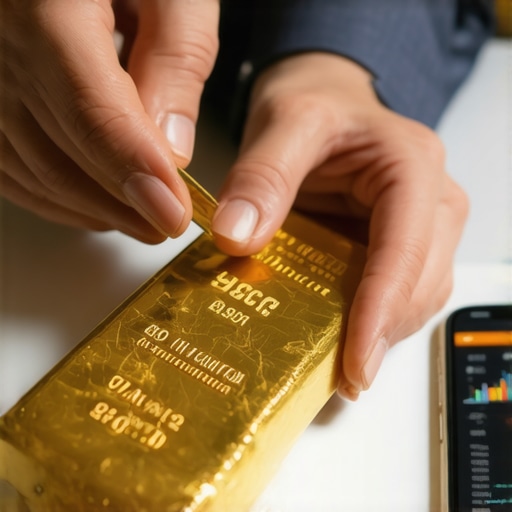Understanding Gold Investment Strategies
When considering investing in gold, it’s essential to explore various strategies that can enhance your overall portfolio performance. Gold has long been viewed as a safe haven asset, especially during periods of economic uncertainty. However, the methods for investing in gold vary, requiring a clear understanding of your financial goals and risk tolerance.
Types of Gold Investments
Investors can choose from a range of gold investment options, including physical gold, gold stocks, ETFs, and mutual funds. Each of these options carries its own risks and benefits. For instance, investing in physical gold provides a tangible asset that can be stored and owned outright, offering a sense of security. On the other hand, gold stocks and ETFs provide liquidity and ease of trading, making them attractive for investors looking for quick access to their funds.
Evaluating Gold Mining Stocks
When investing in gold, many individuals overlook the potential of gold mining stocks. These stocks represent ownership in companies that mine gold, and their performance is often correlated with gold prices. As an investor, understanding the operations, financial health, and market position of these companies is crucial. A well-performing mining stock can significantly boost your returns, especially when gold prices are on the rise.
Gold ETFs and Mutual Funds
Exchange-traded funds (ETFs) and mutual funds are other popular avenues for gold investment. They provide a way to invest in gold without the complexities of owning physical bullion. Gold ETFs track the price of gold and can be traded like stocks, while mutual funds typically invest in a mix of gold assets. This diversification can help mitigate risks while still allowing investors to benefit from gold’s price movements.
Choosing the Right Strategy
Choosing the right gold investment strategy involves assessing your financial situation, risk tolerance, and long-term goals. For example, if you’re a conservative investor, you might prefer the stability of physical gold or gold-backed ETFs. Conversely, if you’re seeking higher returns and are comfortable with market volatility, investing in gold mining stocks or actively managed mutual funds may be more suitable.
It’s also vital to consider how gold fits into your overall investment portfolio. Diversification is key; thus, balancing your gold investments with other asset classes can help you withstand market fluctuations and achieve more consistent returns.
Staying Informed on Market Trends
Lastly, staying informed about gold market trends is critical for making educated investment decisions. Factors such as inflation, interest rates, and geopolitical events can influence gold prices. Regularly reviewing market analysis will equip you with the necessary insights to adjust your strategy as needed.
Advanced Strategies for Investing in Gold
To further refine your gold investment approach, understanding advanced strategies is essential. These strategies not only focus on direct gold investments but also encompass broader market trends and financial instruments, allowing investors to maximize their returns.
Utilizing Gold Futures for Strategic Gains
One advanced method is trading gold futures. This strategy involves contracts that obligate the buyer to purchase gold at a predetermined price on a future date. Investing in gold futures can provide significant leverage, enabling you to control a large amount of gold with a smaller capital outlay. However, this method carries a higher risk due to price volatility, making it suitable for experienced investors who can closely monitor market conditions.
Incorporating Gold Options into Your Portfolio
Another sophisticated approach involves gold options. Options provide the right, but not the obligation, to buy or sell gold at a specified price within a set timeframe. This flexibility allows investors to hedge against price fluctuations while potentially capitalizing on market movements. For those looking to protect their investments, options can serve as a valuable risk management tool.
Analyzing Gold Market Sentiment
Understanding market sentiment is crucial when investing in gold. Keeping an eye on market analysis can reveal insights into investor behavior and expectations, which can influence gold prices. Factors such as economic indicators, geopolitical tensions, and central bank activities play a significant role in shaping market sentiment. By analyzing these elements, investors can make more informed decisions about the timing and scale of their gold investments.
Global Economic Indicators and Their Impact on Gold
The performance of gold is often tied to global economic indicators such as inflation rates, currency strength, and interest rates. For instance, in times of high inflation, gold typically shines as a hedge against currency devaluation. Conversely, rising interest rates can lead to lower gold prices as investors seek higher yields from fixed-income assets. Being aware of these economic influences can help you adjust your investment strategies accordingly.
Understanding the Role of Central Banks
Central banks worldwide play a pivotal role in shaping gold demand. Their buying and selling activities can significantly impact gold prices. For example, when central banks increase their gold reserves, it often signals confidence in gold as a safe-haven asset, which can drive prices up. Investors should stay informed about central bank policies and their potential implications for the gold market, as discussed in recent trends.
Leveraging Gold to Diversify Your Portfolio
Lastly, incorporating gold into your investment portfolio can enhance diversification. Gold often behaves differently from stocks and bonds, making it a valuable asset when economic conditions fluctuate. By strategically balancing gold with other asset classes, you can potentially reduce risk and improve overall portfolio performance. This concept of diversification is critical, as highlighted in various investment strategies.
Understanding Gold Demand Trends and Their Implications
As an investor, grasping the dynamics of gold demand trends is essential for making informed decisions. Demand for gold can fluctuate significantly based on various factors, including economic conditions, cultural influences, and investment trends. In 2025, understanding these shifts will be crucial as they directly impact gold prices and the overall investment landscape.
The Impact of Geopolitical Events on Gold Prices
Geopolitical tensions often lead to increased interest in gold as a safe-haven investment. During times of uncertainty, investors flock to gold, driving up its price. For instance, situations such as trade disputes, military conflicts, or significant political changes can create volatility in global markets, making gold a more attractive option. Staying informed about current events and how they influence gold prices can empower you to make timely investment decisions.
Inflation and Its Role in Gold Investment
Inflation is another critical factor impacting gold demand. As the purchasing power of currency decreases due to inflation, gold typically retains its value, making it a preferred asset for investors seeking protection against inflationary pressures. Understanding the correlation between inflation rates and gold prices is vital for long-term investment strategies. Regularly reviewing gold price forecasts can provide insights into potential market movements influenced by inflation.
Utilizing Gold as a Hedge Against Economic Downturns
Gold has historically been viewed as a hedge against economic downturns. When stock markets experience significant declines, many investors turn to gold to preserve their wealth. This trend underscores the importance of integrating gold into your portfolio as a protective measure. To learn more about how to effectively incorporate gold into your investment strategy, consider diversification strategies that prioritize gold assets.
Advanced Techniques for Gold Trading
Beyond traditional investment methods, there are advanced techniques that savvy investors can employ to enhance their gold trading strategies. These techniques involve a deeper understanding of market mechanics and the use of various financial instruments.
Leveraging Gold CFDs for Enhanced Trading Flexibility
Contracts for Difference (CFDs) are a popular choice for traders looking to profit from gold price fluctuations without owning the physical asset. CFDs allow investors to speculate on price movements and can be used to amplify potential returns. However, they also come with increased risk. Understanding how to navigate CFDs and their associated risks is crucial for anyone considering this trading method.
Utilizing Technical Analysis for Gold Trading
Technical analysis is an essential tool for traders looking to time their market entries and exits effectively. By studying price charts, patterns, and trends, investors can make informed predictions about future price movements. Familiarizing yourself with technical indicators can enhance your ability to identify optimal trading opportunities.
Incorporating Automated Trading Systems
For those who prefer a more hands-off approach, automated trading systems can provide a solution. These systems use algorithms to execute trades based on pre-set criteria, allowing investors to capitalize on market movements without constant monitoring. However, understanding the intricacies of these systems is essential to ensure they align with your investment goals and risk tolerance.
As you explore these advanced techniques, remember that ongoing education and adaptability are key to successful investing in the gold market. The landscape is constantly evolving, and staying informed about the latest trends and strategies will help you maximize your investment potential.
Understanding Gold Trading Strategies
As the gold market evolves, investors must navigate various trading strategies to maximize their returns effectively. Understanding the nuances of gold trading can significantly enhance your investment outcomes. This section will delve into key strategies that are particularly relevant for the current market landscape.
Day Trading vs. Long-Term Investing in Gold
When it comes to gold trading, investors often face the decision between day trading and long-term investing. Day trading involves buying and selling gold within short periods, capitalizing on price fluctuations throughout the day. This method requires a keen understanding of market dynamics and can be particularly profitable in volatile conditions. For those new to gold trading, it’s essential to first explore effective trading techniques that cater to various risk tolerances.
On the other hand, long-term investing focuses on holding gold assets over extended periods, typically in response to broader economic trends. This approach is often favored by those seeking stability and protection against inflation. Understanding how gold prices are influenced by factors such as geopolitical stability and economic indicators can help investors make informed long-term decisions.
Utilizing Leverage in Gold Trading
Leverage can significantly amplify potential returns in gold trading but also increases the risk of losses. Many traders use margin accounts to trade gold futures or options, allowing them to control larger positions than their capital would otherwise permit. However, it’s crucial to approach leverage cautiously; understanding the implications of margin calls and maintaining a solid risk management plan is essential. For more insights on leveraging gold investments, consider reviewing options in gold ETFs and mutual funds.
Risk Management Strategies for Gold Traders
Effective risk management is a cornerstone of successful gold trading. Implementing stop-loss orders can help mitigate potential losses, allowing traders to set predetermined exit points. Additionally, diversifying your gold investments—such as combining gold stocks with ETFs—can reduce overall portfolio risk. For those interested in understanding the importance of diversification further, check out creating a balanced portfolio with gold ETFs.
Monitoring Economic Indicators
Staying informed about economic indicators is crucial for gold traders. Key metrics, such as inflation rates, unemployment figures, and interest rates, can influence gold prices. For instance, an increase in inflation typically drives investors towards gold as a safe haven. To stay ahead, regularly reviewing market analysis can provide valuable insights into how these indicators affect gold demand.
Future Trends in Gold Investment
As we move deeper into 2025, several trends are emerging that could shape the future of gold investment. Understanding these trends is critical for positioning your portfolio effectively.
The Rise of Sustainable Gold Investing
Sustainability is becoming an increasingly important factor for investors. The demand for ethically sourced gold is rising, prompting many investors to consider the environmental and social implications of their investments. By focusing on sustainable gold investments, you can align your portfolio with your values while potentially attracting a new segment of socially conscious investors. To explore the advantages of sustainable gold investments, look into the pros and cons of various gold investment types.
Technological Innovations in Gold Trading
Technological advancements are also transforming how investors trade gold. Digital platforms and mobile apps make it easier than ever to buy, sell, and track gold investments in real time. Being open to using these tools can enhance your trading experience and decision-making process. Consider leveraging these technologies to improve your trading strategy and access real-time market data.
In conclusion, navigating the complexities of gold trading requires a strategic approach and a willingness to adapt to changing market conditions. By continuously educating yourself on the latest trends and refining your strategies, you can position yourself for success in the gold market.
Frequently Asked Questions About Gold Investment
What is the best way to invest in gold for beginners?
For beginners, investing in gold ETFs or mutual funds is often the best approach. These options provide exposure to gold without the need to buy and store physical bullion. They also offer diversification benefits and are easier to manage compared to physical gold.
How does inflation affect gold prices?
Inflation typically drives gold prices higher, as gold is seen as a hedge against currency devaluation. When inflation rises, the purchasing power of money decreases, prompting investors to turn to gold to preserve their wealth.
What are the risks associated with investing in gold mining stocks?
Investing in gold mining stocks carries risks such as operational challenges, management issues, and fluctuating gold prices. Additionally, these stocks may be more volatile than physical gold, making thorough research essential before investing.
Can I invest in gold through a retirement account?
Yes, you can invest in gold through a retirement account, such as a self-directed IRA. This allows you to include physical gold or gold-related assets in your retirement portfolio, providing potential tax advantages.
Is it better to invest in physical gold or gold ETFs?
The choice between physical gold and gold ETFs depends on your investment goals. Physical gold offers tangible ownership and can be a hedge against economic instability, while gold ETFs provide liquidity and ease of trading, making them attractive for investors seeking flexibility.
What factors should I consider before investing in gold?
Before investing in gold, consider factors such as your investment goals, risk tolerance, market trends, and the specific type of gold investment you are interested in. Understanding these elements will help you make informed decisions.
How do geopolitical events influence gold prices?
Geopolitical events can lead to increased uncertainty in financial markets, causing investors to seek safe-haven assets like gold. Events such as political instability, military conflicts, or trade disputes often drive gold prices upward as demand increases.
What role do central banks play in the gold market?
Central banks play a significant role in the gold market by buying and selling gold reserves. Their actions can influence gold prices, as increased purchases by central banks often signal confidence in gold as a safe-haven asset.
Authority Resources for Gold Investment Insights
For those looking to deepen their understanding of gold investment, the following resources provide expert insights and valuable information:
- Kitco – A leading platform for precious metals news and market analysis.
- World Gold Council – Provides research, data, and insights on the gold market.
- Investopedia – Offers a wealth of articles and guides on gold investment strategies.
- CNBC – Features up-to-date news and analysis on financial markets, including gold.
- Bloomberg – Provides in-depth financial news and data on commodities, including gold.
Conclusion
In conclusion, navigating the world of gold investment requires a comprehensive understanding of various strategies, market trends, and economic indicators. Whether you are a beginner exploring gold ETFs or an experienced investor considering advanced trading techniques, keeping informed about the dynamics of the gold market is essential. By leveraging the insights provided in this guide, you can make informed decisions that align with your financial goals and enhance your investment portfolio. Remember, gold remains a valuable asset in times of uncertainty, making it a prudent choice for diversifying your investments.











I’ve been investing in gold for a few years now, and I can definitely relate to the points made in this post about the different strategies. Initially, I focused on physical gold, particularly coins and bars, because having something tangible felt secure. However, I eventually diversified into gold ETFs, realizing the benefits of liquidity and lower storage costs.
It’s intriguing how gold mining stocks are often overlooked. I’ve seen significant returns from a couple of mining stocks I invested in during a price surge in gold. It’s essential to do thorough research on these companies, as operational efficiency can directly influence their stock performance.
I also find that staying updated on market trends is crucial; for instance, fluctuations in inflation rates definitely inform my purchasing decisions. Just recently, I noticed how geopolitical tensions caused spikes in gold prices, prompting me to adjust my investments accordingly.
Overall, it’s an interesting market, and I appreciate how this article covers various aspects such as risk management and the importance of central banks in the gold market. It’s certainly a complex landscape, but with the right strategies, it can be quite rewarding!
Daniel raised some insightful points about the diversity within gold investments. Building on that, I find it fascinating how the choice between physical gold and various financial instruments like ETFs or mining stocks depends so much on individual risk tolerance and investment horizon. For instance, physical gold offers peace of mind through tangible ownership, but it also involves concerns like secure storage and insurance costs, which aren’t trivial to ignore.
In contrast, gold ETFs provide easier liquidity, but they don’t offer the ‘hands-on’ aspect that some investors crave. Regarding mining stocks, their potential to amplify gains during bullish gold markets is clear, but they carry company-specific risks that must be carefully evaluated.
One challenge I’ve personally encountered is balancing portfolio diversification with gold’s unique behavior during market downturns. Incorporating gold as a hedge is sound advice, but allocating too heavily can reduce growth potential during bullish equity markets.
I’m curious—how do others decide how much of their overall portfolio to dedicate to gold versus more traditional assets? And given the emerging trend of sustainable and ethically sourced gold, has anyone shifted their investments to reflect this? It seems like an important consideration given growing investor awareness of environmental and social impacts.